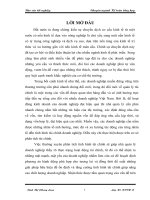19 5 2018 MIXED CHARTS OPINION
Bạn đang xem bản rút gọn của tài liệu. Xem và tải ngay bản đầy đủ của tài liệu tại đây (200.43 KB, 2 trang )
WRITING TASK 1
The table and graph below give information about cinema attendance in Australia between 1994 and 2002.
Summarise the information by selecting and reporting the main features, and make comparisons where
relevant.
Cinema visits for all age groups
Attendance (% of
population attending
cinema)
Frequency (average
no. of visits)
1994
1996
1998
2000
2002
67%
72%
72%
70%
72%
10.7
11.3
8.3
8.4
8.3
Average no. of cinema
visits
Average cinema visits by age group
20
15
10
5
0
1994
1996
1998
2000
14-24 year olds
25-34 year olds
35-49 year olds
50+ year olds
2002
MR. HAN NGO’S SAMPLE (BAND 8.5)
The table shows changes in cinema attendance and frequency, while the line graph provides a breakdown of
attendance according to four different age groups from 1994 to 2002.
Overall, the proportion of the population attending the cinema saw a slight rise throughout the given period,
as opposed to a pronounced decline in the annual number of visits made by an average individual and across
all age groups. It is readily apparent that people aged 14-24 were consistently the most frequent moviegoers.
Regarding the table, 67% of the Australian population went to watch movies in 1994. This figure then rose
markedly to 72% in 1996 and stayed unchanged till 2002 except for a dip in 2000. An average Australian
attended the cinema 10.7 times a year in 1994. This level of frequency peaked at 11.3 in 1996 before
declining remarkably to just over 8 visits till the end of the timescale.
Concerning the line graph, people of all age brackets made fewer visits to the cinema. To be more specific,
attendance for all age groups increased slightly to peaks in 1996 before a dip to their lowest points in 1998.
Numbers started to recover till 2002 when people between 14 and 24 years old made about 10 visits on
average, compared to 8 visits by the 25-34 and over fifties and only 6 by those aged 35-49.
EXAMINER’S SAMPLE
The table shows changes in cinema attendance and frequency on average in Australia from 1994 to 2002,
while the line graph provides a breakdown of attendance according to four different age groups.
Overall, annual attendance witnessed a slight rise throughout the given period. Conversely, the frequency of
visits saw a fluctuating trend with a shift towards recovery at the end of the timescale. It is readily apparent
that people aged 14-24 were consistently the most frequent moviegoers.
According to the table, the proportion of the population attending the cinema rose moderately from 67% to
72% between 1996 and 1998 and remained relatively stable over the period. However, the number of visits
per year saw a less significant increase from 10 to 11 visits in the same period but then fell by 3 and
remained unchanged for the remainder of the period.
In direct correlation with the table, the line graph shows that all age groups seemed to frequent the cinema
more often in 1996 with the lowest attendances recorded among all age groups in 1998. However, numbers
for the 14-24 years old remained moderately higher until the end of the timescale with 10 visits, compared
with their counterparts in other age groups who reflected the national average of between approximately 7
and 8 visits.
WRITING TASK 2
Many people think that media should include more stories which report good news. To what extent do
you agree or disagree?
Many people have argued that a larger proportion of positive news should be included in media content. As I
believe the media should fulfill its mission of telling the truth, such a suggestion seems both irrelevant and
unnecessary to me.
Firstly, there are insufficient grounds for saying that the promotion of more good news is of great benefit to
the public. These news items are popular with people with hectic work schedules under increasing pressure
who need a source of optimism via the news to distract them from their stressful lives. However, such overemphasis on good news can be a form of escapism which makes the public unacquainted with existing
problems that must be faced.
Secondly, I believe that the media should prioritize the reporting of true stories regardless of their levels of
optimism. A disproportionate attention to bad news is likely to generate a negative climate of fear, anger,
anxiety, or hostility among the public. However, a balanced presentation of the facts, no matter how
disturbing, may serve as a strong driver of change towards improvements. If a society has more problems
than achievements, this fact should be reflected as such through more balanced reporting in media channels.
Such a practice plays a pivotal role in heightening public awareness and putting pressure on authorities to
tackle issues.
In conclusion, I am strongly of the opinion that there is no need for the media to promote more good news.
The level of importance, not the character of the news, should be the foremost factor in the process of news
selection.









